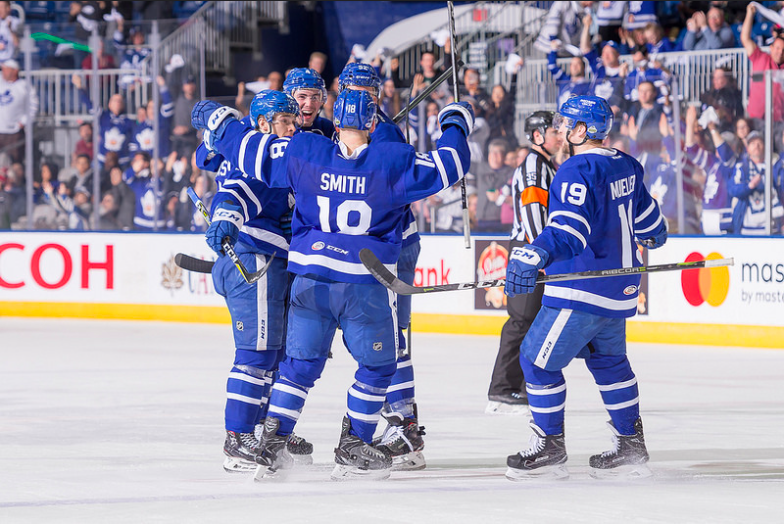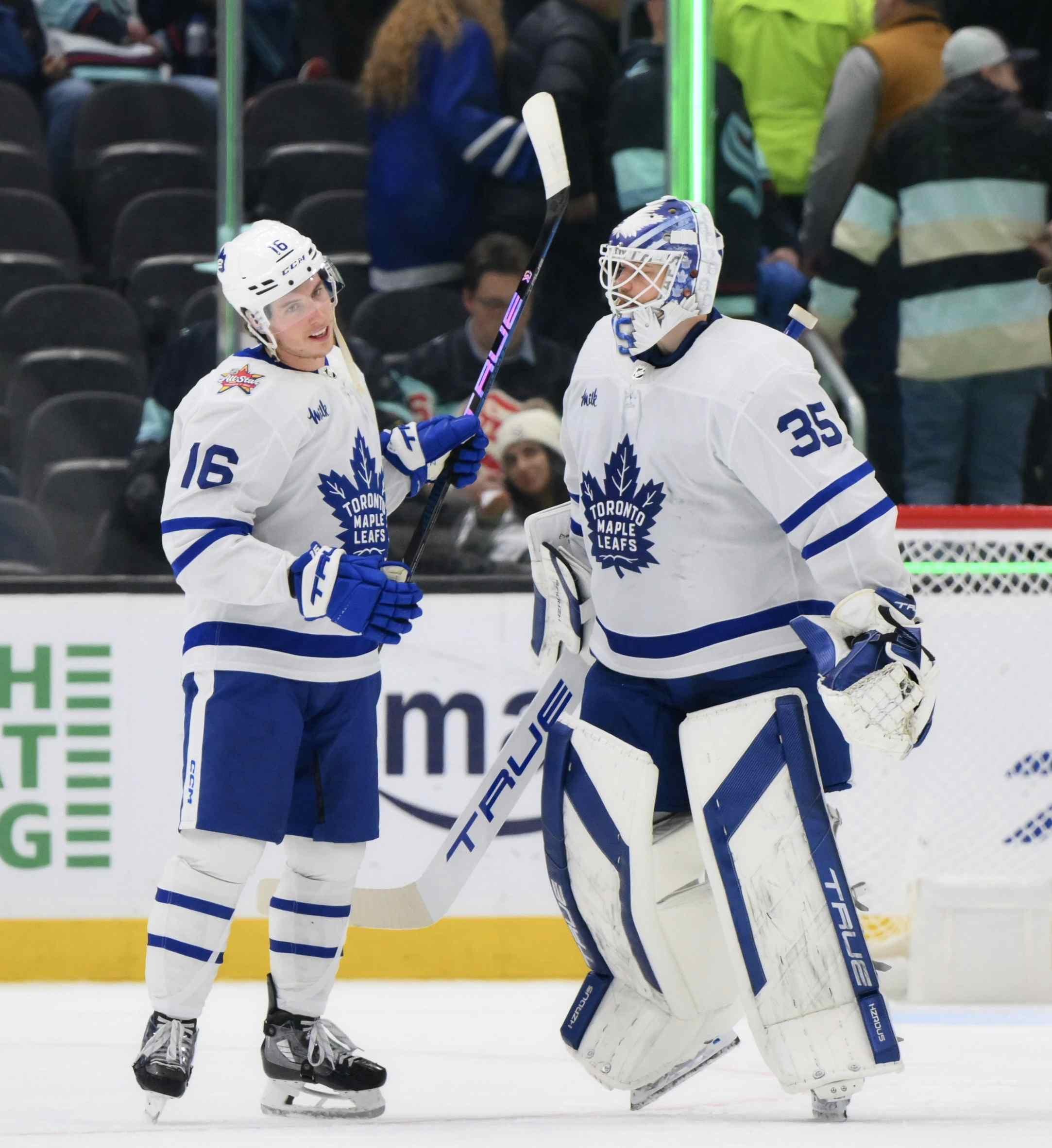The Toronto Marlies have invested heavily in their veterans and it’s paid off

When dissecting the Marlies 2017-2018 first-place campaign, and current Calder Cup Playoff Run, it can be easy to forget about the team’s veteran players, who are arguably the driving force of the Leafs’ affiliate.
They aren’t Maple Leafs prospects, and they certainly aren’t going to get a shot with the Leafs, barring an unforeseen slew of injuries to the big-club.
The Marlies veterans — Ben Smith, Chris Mueller, Colin Greening, Rich Clune, Vincent Loverde and Martin Marincin — aren’t of much interest to Leafs fans at this point. Fans don’t give a damn that Smith and Mueller are amongst the top AHL forwards in the whole league, or that Colin Greening is one of the best skaters on the forecheck, or that Loverde and Marincin are some of the league’s top D-men (we’ll get to Clune, in a bit).
And the reason for that is obvious — they’ll never don a Maple Leafs sweater.
“If you’re say a 32-year-old veteran American hockey league player, the odds of you ever being a regular in an NHL lineup again is really slim,” said player-agent Darryl Wolski, who’s clients primarily play in the AHL and European leagues.
The AHL is evolving, and team’s veteran players, some of whom are amongst the best in the league, don’t get much spotlight, and for most of them, that’s just fine.
“For those guys, they’re making a good living, they do well over here and they’re families like living over here,” Tuscon Roadrunners head coach Mike Van Ryn said. “They like playing the North American game. Those guys take pride in helping organizations create winning cultures. I think there’s a lot of satisfaction in that, for them.”
But unbeknownst to most fans, the Marlies veterans are the organization’s unsung heroes when it comes to prospect development.
The veterans play an integral role in the development of the organization’s young prospects, many of whom are soon to be future Maple Leafs and become full-fledged NHLers.
Now, on the surface, the Marlies veterans are alike many team’s in the league. With AHL team’s only permitted to dress five veteran players — which the league defines as players who have played over 260 professional games — most of the team’s veterans are brought in to accelerate the team’s ability and to set a good example for the younger players along the way.
Yet, what this group of Marlies’ veterans has done for the club, is truly something unique.
Not only are they a big reason why Toronto’s AHL affiliate has a serious shot at hoisting the Calder Cup, but they’ve been almost like a secondary coaching staff to the team. They look out for the younger players, forge friendships with them and overall — keep the dressing room intact, while having a bit of fun themselves.
They’ve been in many of these prospects shoes, before. And with that, they can offer words of wisdom that a coach can’t necessarily.
Marlies head coach Sheldon Keefe has never seen a group of veterans have this much of an impact, on and off the ice, for a team.
“They’re welcoming. They’re friendly,” Keefe said. “They spend time with the young guys. I’ve never seen a group of veteran people that engage with the first year guys, the way that [our veteran players] do.
“Adam Brooks and Jeremy Bracco are as tight with our older guys as I’ve ever seen. It just kind of carries all throughout the team. The way our younger guys engage with the older guys is like nothing I’ve seen. It really speaks to the type of people that [the veterans] are.”
With the exception of Loverde, all the Marlies veteran players have had at least a cup of coffee in the NHL. They know that the journey to get there isn’t easy, and that there’s plenty of room for mistakes, if a young player isn’t guided in the right direction.
“I’ve played at the pro-level for about 12 years and when I was younger, I went through a lot of things,” said veteran forward Rich Clune, who is somewhat of a “team dad” for the group. “I made a lot of mistakes and fortunately i’ve learned from them. It’s put me in a position to be sort of a power of example for the younger guys. And I love it.”

While the veteran players do seem to enjoy helping the young players develop, they’re professional athletes, and this is their way of making a living.
So, what about the AHL, as opposed to, say, professional leagues in Europe, appeals to these bubble players?
Well, first off, it starts with the money.
Financially, the Marlies have invested heavily in their veteran players and it’s payed off big time.
One agent (who is not Darryl Wolski) provided The Nation Network with unprecedented access to the salary figures of AHL veterans.

*This graph does not contain buried contracts (big-league salaries that are buried in the minors).*
As you can see in the graph above, the Marlies spend the fifth most amount, per veteran player, in the entire AHL.
Salaries for Marlies veterans
Colin Greening: $750,000
Vincent Loverde: $700,000
Ben Smith: $650,000
Chris Mueller: $400,000
Rich Clune: $350,000
Playing overseas, a route thats become much more popular with the decline in the quantity of veteran AHL players, doesn’t pay as well as the Marlies do.
According to 2112 Hockey Agency, for which Wolski is the president of, aside from the KHL (where imports can get anywhere from $125,000 to $3 million USD), European team’s usually can’t compete with the Marlies payroll. In the SHL, players can expect around 55,000 to 255,00 USD. In the NLA, players can expect anywhere from $79,911 to $449,500 USD and in the SM-liiga, salaries range from $47,771 to $203,026 USD.
“Once you go [to Europe], you kind of just decide that you’re over there and you’re there for the long-haul and that’s hard for a hockey player,” Van Ryn said. “It’s hard to basically turn the page on something that you’ve worked for your whole entire life and say ‘you know what, I’m just going to be a hockey player. The goal of going to the NHL is over.’’
At the end of the day, the Maple Leafs are the ones cutting the cheques for the Marlies, who play in a league that does not have a salary cap. If they were ever in a bidding war, of sorts, with a player who had an offer from a European club, they could likely match it, or better it, if they so please.

Secondly, for the Marlies, winning and development, goes hand and hand.
“I just think the way the Marlies [develop] is the right way to do it in the AHL,” former Marlies goaltender Drew McIntyre said. “They try to win because I think young guys have to learn to win.”
From 2012-2014, during MacIntyre’s tenure as the Marlies goaltender, he was thoroughly impressed with the team’s balance of not only developing their young-guns, but giving their team the best chance to win.
“It felt like there was always somebody around the room that worked with the team on the developmental side [of things]. It was huge,” he said. “We did our best to win, and both years we had very good team’s. In [2013-2014] we almost won a championship, they added pieces at the deadline and everything for us. You couldn’t ask for anything more there.”
The Marlies veterans want to win a Calder Cup, there’s no question about that. Cashing in a nice cheque and being a nice role model is nice and all, but again, their competitors, and adding a championship to their resume could help them each further their careers, and the Marlies understand that.
“It’s pretty unique for a team to have so many veterans, so driven, not only in work ethic but driven to win and success,” Smith said. “I think that we’re trying to set the tone for this team that the expectations are high”
And the final reason why the Marlies are a hot-spot for these veteran players is that the development isn’t just for the young guys, as Toronto’s AHL affiliate stresses the importance of the development, of all their players.
Marlies general manager, Kyle Dubas along with Keefe, have been very adamant about the development of their older players, too. To veteran players, that means something, as they try to debunk the notion that older players can’t get better.
“The myth that you can’t get better in your late 20s or 30s is completely false,” Clune said. “I think the guys here are a great example, myself included. Even me playing in the NHL, my game from that time, to now, has changed dramatically. The development here with the Marlies stems with all the guys, rookies to veterans.”
The Marlies not only offer a strong paycheque, an opportunity to live in Toronto and a chance to win the Calder Cup, but they also offer a place where they can develop their individual games, with one of the league’s best development program.
In return, the Marlies get some of the league’s best veterans, on, and off, the ice, to lead by example for the team’s young prospects.
It’s a win-win situation that hasn’t only bolstered the development of the team’s prospects, but it’s provided the club with a serious shot to make a Calder Cup Run.
And with the Marlies, winning and development, goes hand in hand.
Recent articles from Jacob Stoller





